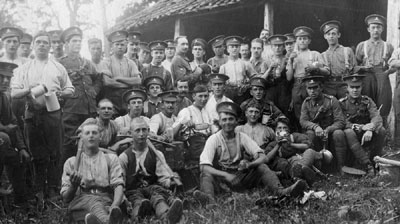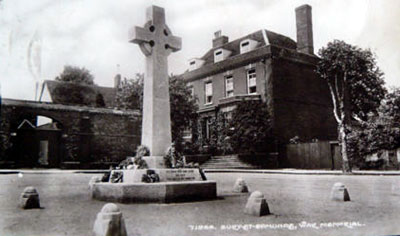
View of the Barracks at Bury St Edmunds seen from West Road. This shows the Keep, which was the Depot of the Suffolk Regiment in 1914. In 1878 the Keep at Gibraltar Barracks was built as a Brigade Depot, to be composed of about 200 men of the 2nd and 3rd Battalions of the 12th Regiment of Foot. They were not called the Suffolk Regiment until 1881. Although used by the local militia, the Regiment later only had about 70 HQ staff on site. The battalions were mainly abroad until 1912.
|

Postcards of the insignia of army regiments were popular before the war. This one shows the badge of the Suffolk Regiment, formerly known as the 12th Regiment of Foot. This led to the regiment being nicknamed 'The Old Dozen'. |

Britain entered the First World War on 4th August 1914, and the regulars and territorials were immediately mobilised. The picture shows the Mowbray block in the Suffolk Regiment's Depot at Bury St Edmunds. It was a familiar sight to regular soldiers, and even to the Territorials who trained here annually, but it must have been a formidable sight for men from Suffolk farms and villages when they first enlisted. |

This picture, labelled "R.F.A. (Northamptonshire), Livermere, Suffolk", by Suffolk Record Office, was the first of Walton Burrell's extensive series of pictures of soldiers during WWI. It is dated August, 1914, and so must have been taken within 3 weeks of war being declared. RFA stands for Royal Field Artillery. |

Although the Great War ended as a mechanised conflict, it started based around horsepower. This view of Samuel Gathercole's Livermere forge shows horses taken into military control for use in the war. They are being shod.
|

Bicycle battalions had long been a part of the British Army, amazing as that seems to us today. Here are the 6th Suffolks in training. Photo by Walton Burrell.
|

However, after signing on at the Gibralter Barracks, there were too many men to be accomodated there. Many units had to live under canvas during training. Here we see soldiers under canvas, photographed by Cousins of Bury St Edmunds. Cousins postcards are distinguished by being a bit sharper than other photographers can manage. |

Soldiers awaiting transport outside the Town Hall in Bury St Edmunds. (Now called the Market Cross) |

There were many more units than just the Suffolk Regiment billetted around Bury St Edmunds. The Royal Engineers camped at Fornham St Martin in 1914. Here they are on parade outside the Woolpack inn. Photo by Walton Burrell of Fornham St Martin. Burrell would photograph many of the units and the injured in hospitals in the area.
|

After parade the sappers lounge outside the Woolpack. Photo by Walton Burrell.
|

River bathing was normal at this time, and these soldiers are thought to be from the camp at Fornham St Martin. |

More off-duty skylarking.
This picture of a boxing pose is just before or after a bathe in the river. It is W R Burrell negative 1319. |

Another picture of the Royal Engineers at Fornham St Martin, Suffolk, in 1915.
Five soldiers appear to be at a gate, but they seem to be standing in a construction of sandbags. Fornham St Martin church is clearly visible in the background. |

Dated to October, 1914, this picture from Suffolk Record Office is titled Field Kitchen at the Tollgate Inn. Ten soldiers with a waggon. The Tollgate Inn is only a few yards from the location of the encampments at Fornham St Martin. |

Individual soldiers are not always identified in these postcards. However, this is R Barkham 415 Lowland Field Company Royal Engineers. He has written on the reverse " Yours Truly Robt. Barkham ". He enlisted on 18.3.1915 and served with the 2/1st London Field Company, Royal Engineers. Posted to France on 23.2.1916 and was at some point attached to the 415th Lowland Field Company, Royal Engineers. His address on discharge was 45 Edinburgh St, Swindon. Birth records suggest he was born in Bury St Edmunds and registered Dec 1881? and married in 1902. Photo by W.R. Burrell, Fornham St Martin, Suffolk. |

The campsite at Fornham seems to have been in use for several years during the war.
This picture is dated 20th May 1916 and shows soldiers of the Norfolk Regiment having dinner near the parish church of Fornham St Martin. |

The 12th battalion, Suffolk Regiment, was originally formed as a bantam battalion (consisting of men between 5 foot and 5 foot 2 inches). Enlistment began on 21 June, 1915 after the war office decided to drop the minimum height of men who were allowed to join the army to 5 foot (previously it had been 5 foot, 2 inches). Recruits came from Suffolk, Essex and Cambridgeshire. One of the main problems during training was that many of the bantams were under the regulation age and parents kept reclaiming them. 133 youths were eventually discharged from the battalion. Here we see the Suffolk Regiment 'Bantams' visited by the Mayor and the General Staff. Note the obligatory spurs.
|

Thought to be a visit of General Smith-Dorrien to troops at Bury St Edmunds. Card posted on 6th July, 1916. |

Units of many branches of the armed forces had to camp around Bury St Edmunds, By no means was the area restricted to the Suffolk Regiment. Here we see members of the Gloucester Hussars encamped at Ixworth. Mr Lonnon, a chemist and photographer in Ixworth, photographed the camp and sold the pictures as postcards, to the troops. The Ixworth village website states that, "The Gloucester Yeomanry were a volunteer cavalry unit and along with others from counties nationwide they were the fore-runners of the Territorial Army. When war with Germany was declared on 4 August 1914 action was taken immediately to provide home defence. To guard against the possibility of an invasion troops were moved towards the east coast." Ixworth received squadron D, while A went to Great Barton Manor and B to Pakenham. They were in Ixworth for only 15 days in August 1914. A year later those who volunteered for overseas service were landing at Gallipoli.
|

Royal Engineers on Livermere heath. |

This view is of "Bury Camp". The location is unknown at present but could be on Hardwick Heath. |

Even when somebody has labelled a postcard, it can be difficult to make much of it. This card has a note which appears to say : '2nd E.A.F.A. R.A.M.C. Bury St Edmunds.' |

This card was posted in Bury St Edmunds in February, 1915. "Just a small group of the Squadron. Smith and I are crossed. Hope you are all well. Kindest regards, K.R." The unit is unidentified at present, but could be Yeomanry. (The Yeomanry were initially cavalrymen, and were divided into squadrons long before the air force existed.) |

This card was photographed at Drew's Imperial Studios at 26 Cornhill, Bury St Edmunds. Repeat orders could quote reference 4194, but we have no idea who these three chums are. |
|
| 
Although most postcards showed tented encampments, we should remember that soldiers were also extensively billeted upon local people. Even at the tented camps, these were likely to be located near village or farm buildings. Company HQ might be set up in a a local hall, the officers would be billeted with the farmer, and the men might also use outbuildings, sheds and barns for sleeping accomodation. This card was dated March, 1918. "Dear Mother, Just a line or two to let you know I am in the pink but this is no fib on this card but we are all happy your ever loving son Bill xxx" |
|


